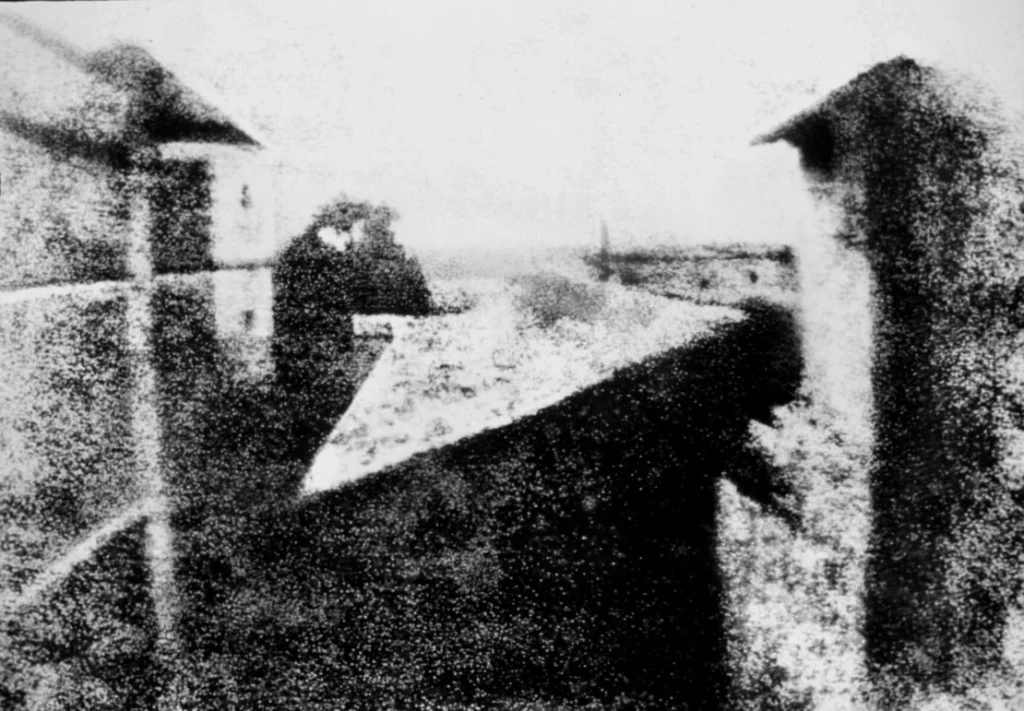Black and white photography, often referred to as monochrome photography, is a style of photography that captures images using varying shades of gray tones, ranging from pure black to pure white, without the use of color. In this form of photography, the absence of color adds a sense of timelessness and a unique aesthetic to the images.
History of Black and White Photography


Image source: Independent photo – View from the Window at Le Gras (1826)
The very first photograph, captured by Joseph Nicéphore Niépce in 1826, was a charming black and white scene from his window. As the followers of the Nicéphore, Louis Daguerre and William Henry Fox Talbot experimented with different techniques to produce black and white images. After that, in 1839, Daguerre’s daguerreotype process was announced, which produced highly detailed black and white images on a silver-plated copper sheet. By following it, in 1841, Talbot’s calotype process was invented to use paper coated with silver iodide to produce negative images, which were then used to make multiple prints.
As time went on, photography got better, but black and white photos stayed cool. Even when color photography came around in the 1900s, lots of photographers still liked black and white. They loved how it looked and how it made them feel.
Unique artistic elements in the black and white photography
Composition : It’s like arranging a photo’s pieces to create visual harmony. With Composition, you can decide how the elements dance within your frame. Without color distractions, you’re free to play with lines, shapes, and angles. Imagine framing a portrait where the subject’s eyes lock onto yours, or capturing a lone tree against an expanse of sky.
Contrast : Imagine a world without shadows—it’d be flat and lifeless, right? Contrast is the hero here, adding depth and drama. It deals between light and dark and infuses your black-and-white shots with intrigue..
Texture : Texture is like the tactile dimension of black and white photography. You can almost touch the roughness of a weathered surface or the softness of a pet’s fur. It’s a feast for your senses, turning visual details into tangible experiences.
Mastering Light and Shadow


Ever wondered how black and white photos seem to come alive, even without color? It’s all about mastering light and shadow. Here are the most important details about using light and shadows to make B and W photographs more stunning.
- Play with Contrast: Experiment with the intensity of light and darkness for striking contrast in your shots.
- Chase the Golden Hour: During sunrise and sunset, the light is soft and warm, casting beautiful shadows.
- Embrace Overcast Days: Clouds act as natural diffusers, offering soft, even lighting without harsh shadows.
- Use Natural Framing: Shadows can serve as natural frames, leading the eye to the main subject.
- Explore Silhouettes: Let objects become silhouettes against a bright background for a dramatic effect.
- Control Light Direction: Modify the angle of light to control the shadows and highlights on your subject.
- Backlight Creativity: Experiment with backlighting to create stunning effects and ethereal silhouettes.
Converting Color to Black and White


Image source: Visual Flow Presets
Converting color photos to black and white is a creative journey. Here’s how you can make the transformation step by step:
- Choose Your Image: Start with a color photo that has potential for a strong black and white presence.
- Use Editing Software: Fire up your favorite photo editing software or app.
- Saturation Slider: Find the “Saturation” or “HSL” option and slide it down to remove color.
- Channel Mixer (Optional): Some software offers a “Channel Mixer” – play with red, green, and blue channels to control tones.
- Contrast and Exposure: Adjust contrast and exposure to enhance the monochrome drama.
- Play with Filters: Experiment with color filters to alter how different colors translate to gray tones.
- Fine-Tune Tones: Use sliders for highlights, shadows, and mid-tones to achieve the desired mood.
- Check Grayscale Preview: Most software has a grayscale preview – use it to gauge the impact.
Tips for Capturing Striking Black and White Shots
Craft your compositions with care, letting each frame tell its story through clever arrangements. Don’t forget to chase the light – shadows and highlights are your dynamic duo for creating depth and drama. Train your eyes to spot textures and shapes that pop in black and white, making your shots truly stand out. Shooting in RAW format gives you post-processing power, while experimenting with ISO and filters adds that extra flair. Embrace overcast days for soft, even lighting, and remember that post-processing is your friend – enhancing contrasts and tones subtly can make your images sing. Every click is a step closer to mastery, so practice and play with passion.
Most importantly, let your emotions guide you – black and white photography captures feelings in their purest form. So grab your camera, embrace the charm of monochrome.
If you have any inquiries, please put them in the comments section below. I’ll answer them in our upcoming blog post!
Happy B&W shooting!






